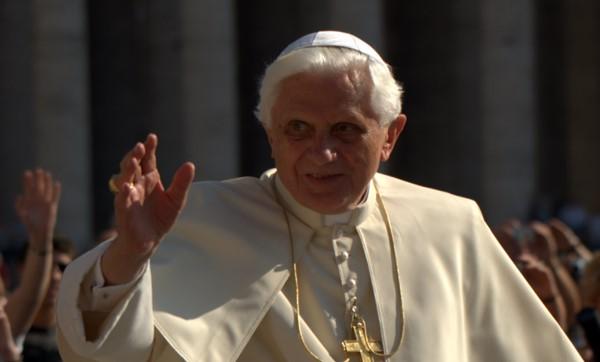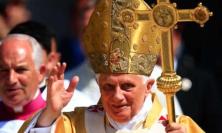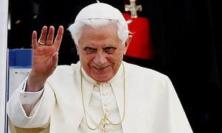Photo shared via Creative Commons (CC BY 2.0)
‘“Christ at the centre”: neither the life, nor death, of Pope Benedict XVI can be appreciated unless this refrain is heard.’ Jesuit theologian James Corkery SJ considers how the priority of relationship, and especially relationship with Christ, shaped the life and theology of the late pope emeritus, who died on 31 December 2022.
A long life with a clear focus
In the Netflix film, The Two Popes, the creators of the film portray Pope Benedict as struggling, and as growing in openness towards the kind of pope – and Church – that he would not instinctively want. This portrayal is thought-provoking, even if it is not historical fact. Benedict is depicted as beginning to see the need for a highly pastoral, outgoing, ‘eggshell-breaking’ kind of pope (like Bergoglio might be) if the Church is to maintain some relevance in the lives of contemporary men and women. And so he is presented as slowly opening up to something, even to someone, he would not naturally choose. This seems to be an accurate assessment of him in character somehow, because he had loved the Church intensely his entire life, and his disposition was to act for its benefit rather than for his own. In his short discourse to the cardinals on the day he departed the Papacy (28 February 2013), he quoted a text of Romano Guardini saying that the Church ‘is not an institution conceived and built in theory... but a living reality.... She lives through the course of time, in becoming, like every living being, in undergoing change.... And yet in her nature she remains ever the same and her heart is Christ’.[1] Pope Benedict saw that the Church would adapt to his resignation, as it has ever adapted (eventually!) to changing times while remaining true to its nature as the living, beating heart of the Christ who is always its Lord. Benedict listened to that heartbeat for almost a century of life. In a touching exchange with children who had received their first communion during the year he became pope, he made this clear when one of them, Andrea, asked him what he remembered of his first communion day:
...on that day I was really filled with great joy, because Jesus came to me and I realized that a new stage in my life was beginning, I was 9 years old, and that it was henceforth important to stay faithful to that encounter, to that communion. I promised the Lord as best I could: ‘I always want to stay with you’, and I prayed to him, ‘but above all, stay with me’. So I went on living my life like that; thanks be to God, the Lord has always taken me by the hand and guided me, even in difficult situations.[2]
‘Christ at the centre’ has been a constant refrain in the thought of Benedict, has given direction to his actions and has guided his feet towards his encounter, finally, with the same Lord in person earlier today. Regarding himself, he was aware that he was not lacking in inadequacies, shortcomings, even defects, but his relationship with Christ was the focus of this imperfect life, its thoughts, its words, its deeds, as Benedict sought to stay faithful to the ‘lifelong friendship with Jesus’ that marked the beginning of a ‘new stage’ in his life on the day that he received his first communion in March 1936.[3] One cannot understand this man without appreciating the centrality of this relationship – for him, and also as something that he fervently wished to commend to others.
Stepping into the presence of God forever
Death did not take Benedict XVI unawares; and this was not simply because, at 95, it is impossible not to be aware of its nearness, but also because he was a reflective person who, without morbid preoccupation, was aware that death was coming; indeed it formed part of the horizon towards which he had always lived his life. The question of what lay beyond that horizon was inescapable, for believer and unbeliever alike, as the young theologian Joseph Ratzinger had already shown in his treatment of the great ‘perhaps’ that troubled the minds of each in his Introduction to Christianity.[4] Pope Benedict XVI walked, with open eyes, towards his death. Asked by Peter Seewald, in 2016, if he feared death – or at least, dying – he responded:
In a certain sense, I do. First of all, there is the fear that I would become a burden to people through a long period of being handicapped. I would find that very sad. My father also had a great fear of that but he was spared it. The other aspect is that, amid all the trust that I have that the good God cannot throw me away, I can nevertheless also, the closer I come to standing before his face, ever more strongly feel how much I have done wrongly. Insofar as this is there, the burden of guilt oppresses one also, although the fundamental trust is always, naturally, there.[5]
Seewald continued, asking him: ‘What weighs on you there?’ He replied:
Well, that one again and again was not sufficient for people, that one had not treated them rightly. Just there, there are so many details, not very crass things, thank God, but yet so many things of which one must say: that could have and should have been done better – where one was not quite just to the people, or to the matter.[6]
Then Seewald asked: ‘When you stand then before the Almighty, what will you say to Him?’
Benedict XVI replied: ‘I will ask Him to show leniency towards my shabby state.’
So Benedict was as ready as any believing, thinking person for what happened to him today and his death did not come to him like a thief in the night. He expected it and had thoughts about it. He was consciously preparing himself for it. From what he said in response to Seewald, we know something of those thoughts. But there was not only the aspect of a certain fear at the image of standing before God. There were also very positive expectations, as we know from his voluminous writings on questions of eschatology – on what theology traditionally called ‘the last things’ – and which included, for him, not just the individual’s fate but also the fate of that entire fabric of relationships that one had lived in the course of one’s life. With the individual human being there is also his or her history, the good he/she has done for and with others; the good that he/she has failed to do, instead giving space for evil to gain traction in the world; the entirety of a person’s involvements, omissions and commissions. One brings all this, all this that is part of one’s history, to the final encounter with the Lord.[7] Benedict knew and was preparing himself consciously for that – facing all of it, both what made him fearful and what filled him with joyful expectation, based on the ‘fundamental trust’ that, he said, ‘is always, naturally, there’. When Peter Seewald, in the ‘last conversations,’ suddenly ‘switched track’ to ask him: ‘but the believer trusts that “eternal life” is a fulfilled life?’, Benedict responded energetically: ‘oh yes, that above all!’[8] And included in that one could see how, for him, many elements were contained: confidence in God’s promise of mercy and forgiveness; the immense joy of being in God’s presence forever; a fulfilled life; an existence of well-being beyond all possible imagining, with the gift of being, once again, with family and friends – once more, just ‘as it was for us at home.’[9] To all of this Benedict XVI, in trusting, even simple, faith was looking forward.
The key to Pope Benedict’s faith in God during his life, and at the moment of death, was relationship; and the crucial relationship had always been, for him, his relationship with Jesus Christ. One remembers it from his description of his first communion with which these reflections began.[10] So many of his writings were centred on ‘the Lord’, and his speech, in whatever language he was using, was forever speckled with the words ‘der Herr’, ‘il Signore’, ‘the Lord’. I remember this last, in English, from an interview he gave – one of the few ever in (surprisingly good!) English to Raymond Arroyo of EWTN, in 2003, as they were discussing crises in the Church and the world and the then cardinal kept saying that faith, faith in the Lord and closeness to him, was the key to overcoming all the difficulties. And by such faith he meant a living relationship with the Lord that coloured every aspect of life. The indispensability of such faith had also been to the fore in his New Year’s Eve homily of 1977 (in which he spoke of sin as a loss of faith in God, an Augustinian theme) and of how different terrorisms, based in various ways upon Marxism, come down in the end to trying to assume the role of divine providence, because once faith in God is lacking, the assumption is that the terrorists themselves must guide history, and so they act as, in their imaginations, they think a God would act.[11] Faith – the relationship with Jesus Christ that faith is – was strikingly to the fore in the first paragraph of Benedict XVI’s first encyclical, Deus caritas est, in 2005;[12] and six years later, in a motu proprio promulgating the Year of Faith in October 2011, entitled Porta fidei, the theme of faith-as-relationship-with-Christ was once again central.[13] This theme is a key to Ratzinger, the key to his life and identity. Although he has written much about love, faith seems to have been even more prominent in his mind because it is by faith that our imperfect human love is perfected: we throw ourselves in faith on Christ whose love-to-the-end (John 13:1) makes up for our deficient love – making this love ‘sufficient’ through faith.[14]
Perhaps, in these reflections touching into how Pope Emeritus Benedict would have been disposed to embrace death when it came for him today, we do well to focus on this faith that is at heart relational. Joseph Ratzinger’s whole understanding of the redeemed human being, patterned on the Christ (the New Adam) who loved to the end, dying with his ‘arms outstretched on the wood of the Cross’,[15] would surely have been in his mind as he stepped, drawing his last breath, into the open arms of this Christ. And so his ‘fundamental trust’ would have won out over his keen awareness of his need of mercy and forgiveness. It cannot have been otherwise because this is the horizon into which he lived, no matter what his struggles and shortcomings were. In his thinking over the years about life after death and the salvation of the world, he transposed the (statically understood) substantialist notion of ‘having a soul’ into the vital, relational idea of a human existence being always in the dialogical embrace of God. He saw how the traditional idea of people ‘having a spiritual soul’ meant ‘precisely being willed, known and loved by God in a special way’ and thus ‘being a creature called by God to an eternal dialogue and therefore capable for its own part of knowing God and of replying to him.’[16] A host of important points (that we can barely mention here) follow from this: that to be human is to be addressed and to be gifted with the capacity to respond – we can answer God, we can pray, we are homo orans, because God first spoke to us. Also, the dialogue into which we are called is an eternal one because the memory of God, our dialogue partner, can never fail. Thus our immortality can be termed ‘dialogical’ and this is the name (dialogical immortality) that theologian Ratzinger first gave to this idea in 1967, and again in 1977, just before changing from being a theology professor in Regensburg to being archbishop of Munich.[17] At heart it means that to be human is, above all, to be in dialogue with God and that this is the key to life – and so to death also. This is why it is not far-fetched to think of Benedict XVI approaching his death in conversation with God and entering more deeply into that dialogue with God that had been going on all through his life.
Before finishing, mention must be made of two other aspects of dialogical immortality that have not yet fully surfaced: the place of Christ in the dialogue and the presence of other human beings. From his studies of revelation, Joseph Ratzinger became aware that God’s addressing of humanity occurs supremely in his Word, in his son Jesus, God’s Word spoken to the world. And if God, in Jesus Christ, steps towards us in this way, as this Word of love, then there can be nothing to fear as, in death, we step towards him. Nor does such movement into Christ take place in isolation for, even though it is a person’s final act, ‘present’ also are all those whose lives he impacted, and whose lives affected his, most especially the ones he came to know and love as members of the one body of Christ. Including in his dialogical immortality both the central role of Christ and the presence of one’s sisters and brothers in Christ, Ratzinger/Benedict wrote:
Man (sic) is not engaged in a solitary dialogue with God. He does not enter an eternity with God that belongs to him alone. The Christian dialogue with God is mediated by other human beings in a history where God speaks with men. It is expressed in the ‘We’ form proper to the children of God. It takes place, therefore, within the ‘body of Christ,’ in that communion with the Son which makes it possible for us to call God ‘Father.’ One can take part in this dialogue only by becoming a son with the Son, and this must mean in turn by becoming one with all those others who seek the Father.[18]
‘Christ at the centre’ is the refrain sounding at the end of these reflections, just as it did on the very first page. Neither the life, nor death, of Pope Benedict XVI can be appreciated unless this refrain is heard. No doubt, when the end came, the ‘Christ at the centre’ called out to him: ‘do not be afraid, it is I...’ (Rev. 1: 12-17...)[19] and he stepped forward into the bright darkness, to continue his dialogue with the familiar voice, all else falling away as, in ‘fundamental trust,’ he responded: ‘I am not afraid; it is you; I am home!’ And Simeon’s prayer, ‘Now Lord you let your servant go in peace,’ was once again answered by the good and merciful God.
Fr Jim Corkery, a Jesuit from Limerick, Ireland, is Ordinary Professor of Theology in the Departments of Fundamental and Dogmatic Theology at the Pontifical Gregorian University in Rome. He has written a book and several articles on the theological ideas of Joseph Ratzinger/Pope Benedict XVI.
[1] ‘Farewell Address of His Holiness Pope Benedict XVI to the Eminent Cardinals Present in Rome,’ 28 February 2013, available at www.vatican.va (last accessed on 16 August 2022).
[2] Pope Benedict XVI, ‘Catechetical Meeting of the Holy Father with Children who had Received their First Communion during the Year, St. Peter’s Square, Saturday 15 October 2005 (last accessed on 13 August 2022 at: https://www.vatican.va/content/benedict-xvi/en/speeches/2005/october/documents/hf_ben_xvi_spe_20051015_meeting-children.html
[3] Ibid.
[4] Joseph Ratzinger, Introduction to Christianity. Translated by J.R. Foster, with a New Preface translated by Michael J. Miller (San Francisco: Ignatius Press, 2004; original German 1968), pp. 46-47.
[5] Peter Seewald’s final interview with Benedict, published under the title Letzte Gespräche (München: Droemer Verlag, 2016), p. 35.
[6] Ibid., p. 36.
[7] Joseph Ratzinger, as a theologian, has had much to say on how our final encounter with the Lord is not an isolated affair. All our ‘involvements’ are present in it, all our relationships, all of our histories – with their successes and failures. For greater insight into the social aspects of human-divine encounter, see, for example, Introduction to Christianity, pp. 351-354, and Death and Eternal Life (Washington DC: The Catholic University of America Press, 2nd Edition 2007, original German 1977), pp. 158-160. See also the penultimate paragraph of these reflections.
[8] Letzte Gespräche, p. 36.
[9] Ibid.
[10] See ‘Catechetical Meeting of the Holy Father with Children who had received their First Communion During the Year.’
[11] See ‘Terrorismus, Menschlichkeit und Kirche. Aus Silvesteransprachen an der Jahreswende 1977/78. Kardinal Ratzinger: Die Signatur des Jahres’ in Herderkorrespondenz 32 (1978): 85.
[12] See Encyclical Letter, Deus caritas est, 25 December 2005, available at www.vatican.va, §1: ‘Being Christian is not the result of an ethical choice or a lofty idea, but the encounter with an event, a person, which gives life a new horizon and a decisive direction.’
[13] See Apostolic Letter ‘motu proprio data’ Porta fidei of the Supreme Pontiff Benedict XVI for the Indiction of the Year of Faith, last accessed at www.vatican.va on 14 August 2022, §11, where the pope, writing about the Catechism of the Catholic Church, says: ‘On page after page, we find that what is presented here is no theory, but an encounter with a Person who lives within the Church.’
[14] See Joseph Ratzinger, Vom Sinn des Christseins (Munich: Kösel Verlag, 2005; original edition by Kösel 1965), pp. 98-99.
[15] Arme ausgebreitet am Holze des Kreuzes: these words from the Second Eucharistic Prayer (Preface) in German would have become deeply familiar to Joseph Ratzinger over the years.
[16] Joseph Ratzinger, Introduction to Christianity, p. 355.
[17] See Joseph Ratzinger, Introduction to Christianity, pp. 350, 352 and 354-355. See also his Death and Eternal Life, pp. 150-153 and 157-160.
[18] Death and Eternal Life, p. 159.
[19] Note that these are the words of Scripture with which Pope Emeritus Benedict ends his letter of 8 February 2022 in response to reading the Report of the Munich Archdiocese and as he reflects that ‘Quite soon, I shall find myself before the final judge of my life.’






